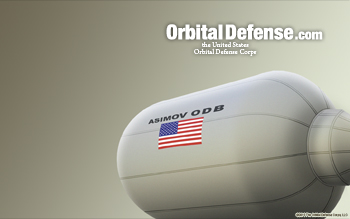The Orbital Defense Base
Although the development of the V-Series Destrier fighter craft has garnered a great deal of media attention in recent months, the establishment of four semi-permanent military outposts in geostationary orbit above the U.S. mainland was an equally crucial step towards the fulfilling of the Gryphens’ mandate.
Each orbital defense base (or ODB) was named in honor of a popular science fiction writer from the last century and serves as home to one of the ODC's combat squadrons. The fifteen habitats that form each station are of the XA 420 design, originally developed by Xavier Aerospace in the 1990s for a government-sponsored project that was ultimately canceled. Twelve of these habitat modules form the main complex of each ODB: six dedicated to living quarters, with five more for HQ/communications, kitchen/dining, exercise, flight training, and life support, the twelfth module to serve as a machine shop for the techs' use in maintaining both the station and the fighter craft. The modules are arrayed along a corridor that sports a recyclable airlock at each end as well as one in the middle. The Destriers dock along a 120-foot-long girder which meets a station airlock at one end and, at the other, the module used for storage of ordnance.
The two remaining modules are defensive gun emplacements located at the end of similar girders emerging from opposite sides of the main corridor, placed near the airlock halfway down the corridor's length. Neither the ordnance module nor the defensive modules are pressurized, due to the presence of explosive munitions; were they to be included as part of the main complex, any explosion in one of the three—no matter how small—could take out the entire base. Since the cockpits in the Destriers themselves are also unpressurized, there is no need for a "covered" passage to the ships.
In total, each base measures 250 feet long and 100 feet across in the main complex, not counting the outlying gun emplacements. It's not terribly pretty to look at, sporting none of the sweeping curves characteristic of so many fictional space stations, but it's functional and as safe as the engineers know to make it; compartmentalization is key, as each module will remain closed off from others in combat situations, preventing destruction of the entire base in the event that any of the habitats are compromised.
Each habitat module provides roughly 10,000 cubic feet of living/working space and consists of a multi-layered inflatable hull much stronger than even the materials used in bullet-proof body armor; the ODB's skin is more than a foot thick, designed to prevent punctures from micrometeorites traveling many times faster than a speeding bullet. It also provides insulation against both the extreme radiation and the extreme shifts in temperature that can occur in space, depending on whether the base is in direct sunlight or shade.
The habitats were collapsed and launched into orbit in May aboard medium-lift rockets. They were followed a week later by the engineers responsible for assembly, who were transported aboard the legendary space shuttles Discovery, Atlantis, and Endeavor, which were brought out of retirement just for this special occasion.
|










